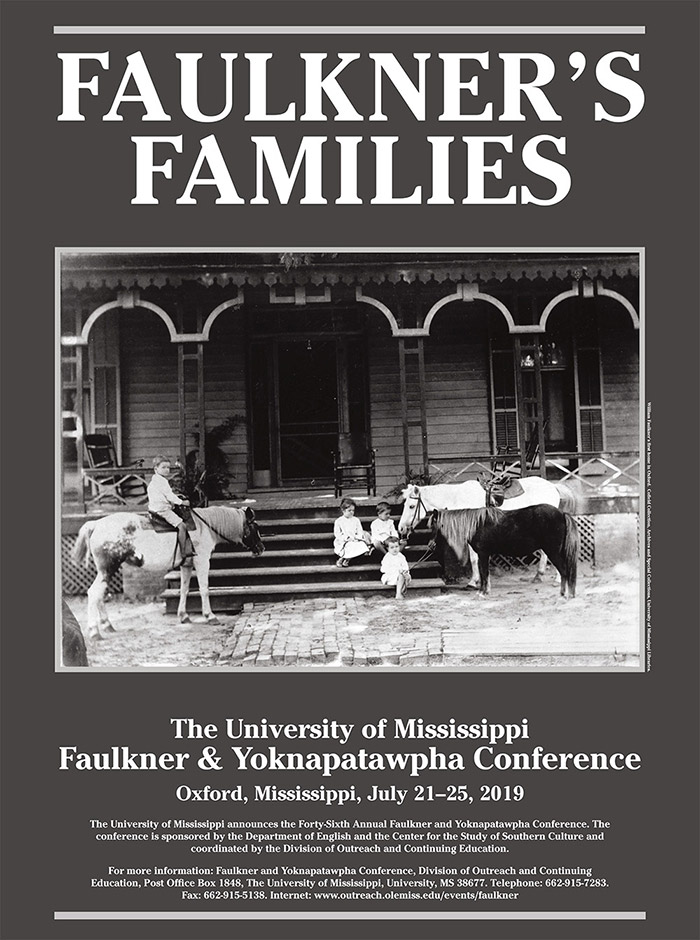
Panel. Subversive, Transnational, and Functional Genealogies
Location
Nutt Auditorium
Start Date
24-7-2019 9:30 AM
Description
- Faulkner’s Subversive Genealogies / George Porter Thomas, Georgia Institute of Technology
Faulkner’s family trees trace what Judith Shklar calls subversive genealogies: the rediscovered roots of Sutpens and McCaslins come to frame not a sacralized patrimony but instead primal iniquity—their genealogies are self-defeating. Yet Faulkner’s frontier South, hacked out of the wilderness by dubious arrivistes, becomes more than just an exposé of rotten dynasties. Because Faulkner’s fallen scions can trace bloodlines to their sordid beginnings in the space of a few generations, Yoknapatawpha becomes an investigation, in miniature, of genealogy itself. Reading Go Down, Moses and several intertexts, I ask if Faulkner suggests some other, better, conception, a “distaff genealogy.” But I also explore a more radical reading: what if it is not just the Southern past we have been looking at all wrong, but the idea of the past itself? What if what needs reconsidering is not just the pasts of these families, but also the way that we tend to view the past in familial terms? - “A fierce rigid umbilical cord”: Timeless, Boundless, and Transnational Genealogy in William Faulkner’s Absalom, Absalom! / Hyoseol Ha, State University of New York, Buffalo
This paper examines how Faulkner’s “house” as a central trope (un)knots the American South, the United States, and the Americas. Basic concepts of knot theory in mathematics will be used. While divided into independent regions and yet brought together as one common space that shares geographical boundaries, the three regions, when seen from a three-dimensional topological view, are inextricably intertwined. Faulkner’s houses—Sutpen’s Hundred, the Coldfields’ house, and Quentin’s Harvard dormitory room—create a narrative that renders borderlines ambiguous and places the distressed characters at a hemispheric crossroads. This paper also discusses how Faulkner’s novel itself stands as a written house, different characters’ stories in each chapter forming individual rooms and the endless flow of time surrounding their stories becoming the wall that has no beginning or end. Altogether, the text transcends time and space, allowing Faulkner’s families from the American South, the U.S., and the Americas to converge. - "You See Indeed How the Child is Father of the Man": Faulkner's Functional Families / Terrell Tebbetts, Lyon College
Relational Format
Conference proceeding
Recommended Citation
Thomas, George Porter; Ha, Hyoseol; and Tebbetts, Terrell L., "Panel. Subversive, Transnational, and Functional Genealogies" (2019). Faulkner and Yoknapatawpha Conference. 22.
https://egrove.olemiss.edu/fy/2019/schedule/22
COinS
Jul 24th, 9:30 AM
Panel. Subversive, Transnational, and Functional Genealogies
Nutt Auditorium
- Faulkner’s Subversive Genealogies / George Porter Thomas, Georgia Institute of Technology
Faulkner’s family trees trace what Judith Shklar calls subversive genealogies: the rediscovered roots of Sutpens and McCaslins come to frame not a sacralized patrimony but instead primal iniquity—their genealogies are self-defeating. Yet Faulkner’s frontier South, hacked out of the wilderness by dubious arrivistes, becomes more than just an exposé of rotten dynasties. Because Faulkner’s fallen scions can trace bloodlines to their sordid beginnings in the space of a few generations, Yoknapatawpha becomes an investigation, in miniature, of genealogy itself. Reading Go Down, Moses and several intertexts, I ask if Faulkner suggests some other, better, conception, a “distaff genealogy.” But I also explore a more radical reading: what if it is not just the Southern past we have been looking at all wrong, but the idea of the past itself? What if what needs reconsidering is not just the pasts of these families, but also the way that we tend to view the past in familial terms? - “A fierce rigid umbilical cord”: Timeless, Boundless, and Transnational Genealogy in William Faulkner’s Absalom, Absalom! / Hyoseol Ha, State University of New York, Buffalo
This paper examines how Faulkner’s “house” as a central trope (un)knots the American South, the United States, and the Americas. Basic concepts of knot theory in mathematics will be used. While divided into independent regions and yet brought together as one common space that shares geographical boundaries, the three regions, when seen from a three-dimensional topological view, are inextricably intertwined. Faulkner’s houses—Sutpen’s Hundred, the Coldfields’ house, and Quentin’s Harvard dormitory room—create a narrative that renders borderlines ambiguous and places the distressed characters at a hemispheric crossroads. This paper also discusses how Faulkner’s novel itself stands as a written house, different characters’ stories in each chapter forming individual rooms and the endless flow of time surrounding their stories becoming the wall that has no beginning or end. Altogether, the text transcends time and space, allowing Faulkner’s families from the American South, the U.S., and the Americas to converge. - "You See Indeed How the Child is Father of the Man": Faulkner's Functional Families / Terrell Tebbetts, Lyon College

